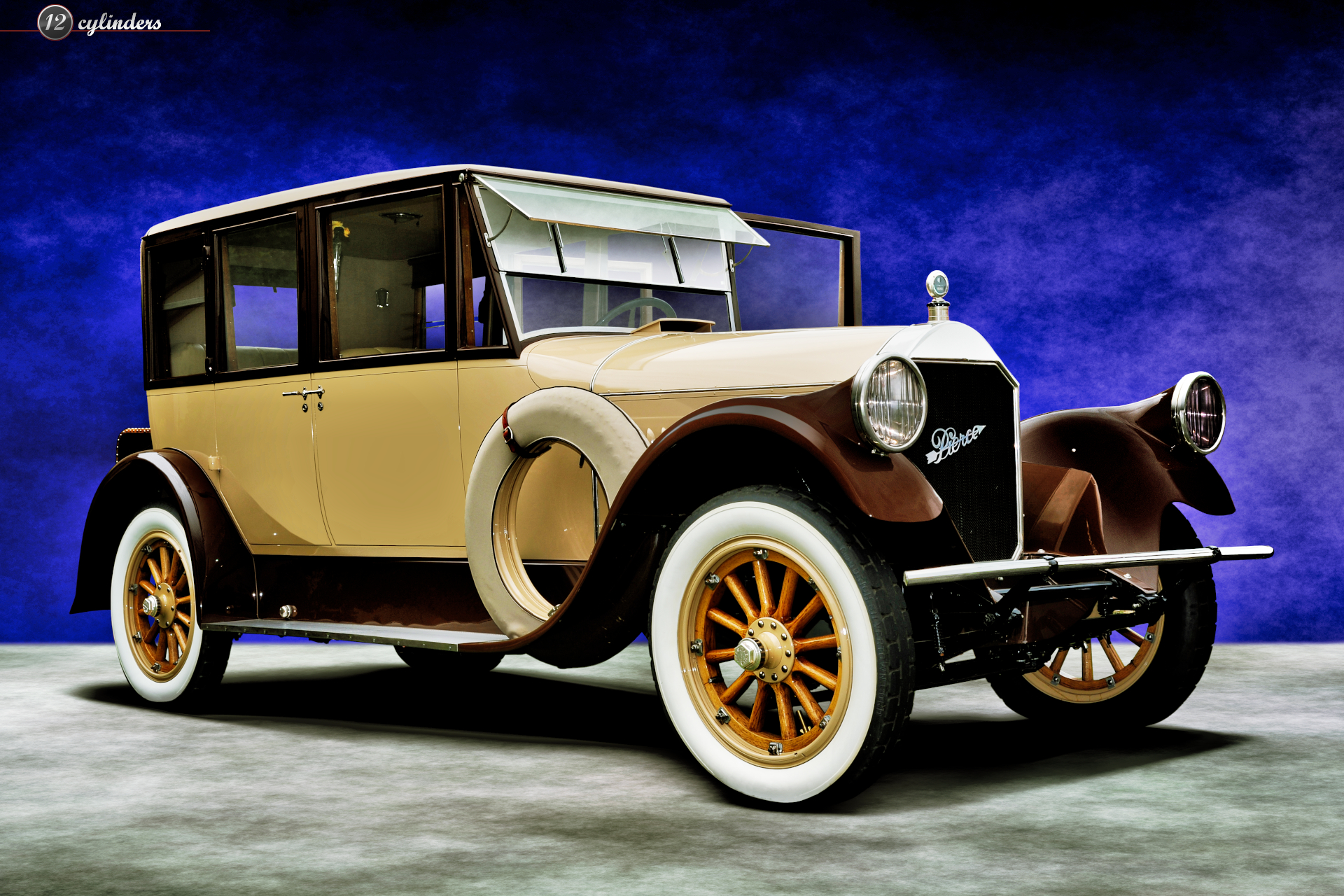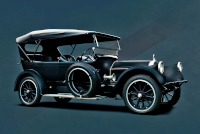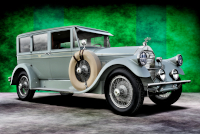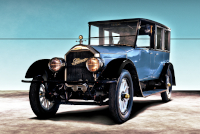Location:
Elegance at Hershey, 2013
Owner: Keith Miller | Hershey, Pennsylvania
Prologue:
We encountered #332157 in Hershey on two occasions, and I snapped a lone photograph out of respect for the marque on the second meet. I do not suspect claims of Milton S. Hershey connections are true, but rather appreciate where the Model 33 falls in the scope of Pierce-Arrow history. Through the early 1920s, the Model 33 dragged the company through recession and back into prosperity; it is a less visceral product than it is a business necessity. And without a member of Model 33 series production (or the rare Model 32), our history would be incomplete. So as I compile the Pierce-Arrow portfolio, I'm happy to have taken a moment to collect this car.
- - - - - - - - - -
► Image Source: Nikon D700 (12.1 MP)
References:
- Ralston, Marc. "Pierce-Arrow" A.S. Barnes & Co., Inc., San Diego, CA. 1980, page 115-119, 231
- Automobile Quarterly, Volume 6, Number 3, Third Quarter 1968, "Pierce-Arrow: An American Aristocrat" by Maurice D. Hendry, The Kutztown Publishing Company, Inc., Kutztown, PA, page 256
- Bonhams: The auction listing for #332157 at Bonhams' October 2008 Larz Anderson Auto Museum sale. Note the reference to Milton S. Hershey and its disclaimer. Perhaps more likely, Hershey's actual car was the 1915 Model 48-B Vestibule Suburban, chassis #13304, though I find no ready evidence in either case.
- Riga Master Workshop: A sales listing for #332157 with concise model history.
The big Pierce-Arrow car of the early 20s is not so big. As of the Model 32's introduction in 1920, Pierce-Arrow offers a 138-inch chassis and nothing more. The Model 32 and 33 will see Pierce-Arrow through recession, but these are somewhat different animals than their predecessor, the Model 31. Gone is the cast-aluminum body, and with it the smooth lines of the great Pierce-Arrow touring cars. In its place, flat-panel utilitarian sedans carry the banner. Gone is the four-speed gearbox, which is somewhat odd in retrospect, to think that Pierce-Arrow had fitted four-speeds for so many years prior to the 1920s. But gone too is the rather colonial right-hand drive configuration, perhaps the last American hold-out, presumably missed only by those who fancied themselves the American equals of continental marquises. So, from the Model 31 (and to some extent, the Model 51), the Model 32 and Model 33 cross a transitional divide in Pierce-Arrow development.
What remains, however, is the four-valve-per-cylinder motor. Formerly the Series 5 Dual-Valve inline-6, ("dual-valve" being Pierce-Arrow's term for two each of intake and exhaust valves), the internal dimensions remain as before but the unit is now a single cast with a removable head. Ralston notes that the cylinders walls are comparably thinner, which makes the block prone to cracking if not run adequately lean. But the mono-block (or "en bloc") method maintains the performance of the already superlative Model 31.
Business Transition as Key People Leave Pierce-Arrow
Not so surprisingly, the physical transition evident in the shift from the Model 31 to the Model 32 and 33 aligns with a great deal of organizational transition in Pierce-Arrow management. In 1920 the Goethals & Co. consulting firm lay its influence into operations, the chief product of which is the Model 32. David Fergusson, the English ex-patriot whose engineering prowess made Pierce-Arrow a bulletproof, high-performance luxury automobile, left as a result. Long upset with the board's refusal to bend on certain conservative positions (the viability of the V-configuration motor, for instance), Goethals' poorly informed hunt for new solutions founded in much less science pushed him beyond the limit.
A year later, Colonel Charles Clifton, who had joined the George N. Pierce Company in 1897 when the firm's top transportation product was a bicycle, finally retired from the board. For better or worse, his stalwart attitude had created the immensely high standards to which the factory aspired, and which its products mainly achieved. In this time, Colonel George W. Mixter stepped in for a two-year stint as president, a man of Goethals & Co control.
Mixter lasts only till November of 1922, replaced by Myron Edison Forbes. April 1922 also brings plans to merge with Lafayette Motors. But a gradual claw out of recession and a return to form under refinement of the Model 33 and expansion toward the more attainable Model 80 removes need of external support. After those few tumultuous years, Pierce-Arrow rebounds.
By way of figures, company profit in 1922, the year of our example here, touches no more than $10,000. But Model 33 sales will double in 1923. And by 1925 profits will reach $1.6 million. So through this transition, Pierce-Arrow survive; they lose the driving minds behind the business and engineering, but keep in tact their philosophy.
Motor: 6,796 cc (marketed as 415 cubic inches, actual 414.7) Dual-Valve inline 6-cylinder | 101.6 mm x 139.7 mm (4" x 5½")
single cast "en bloc" with removable head
Valvetrain: T-head, 4 valves per cylinder, twin-plug ignition via Delco dual distributor with two plugs per cylinder
The two banks of spark plugs can be operated independently or in unison via dashboard switch control.
Aspiration: single Stromberg carburetor
The Model 32 first used the Stromberg unit, which replaced Pierce-Arrow's own design.
Power: 100 hp @ 3,000 rpm
Output would at least equal the Model 31 at 72 hp, but with a speed increase from 2,600 rpm to 3,000 rpm the actual figure approaches 100 hp.
Drivetrain: 3-speed manual transmission, rear-wheel drive
The 4-speed gearbox retired with the Model 31, as did right-hand drive.
Architecture: steel frame, aluminum sheet body panels over white ash frame
Wheelbase: 3,505.2 mm (138 inches)
Top Speed: 115.8 km/h (72 mph)
Etymology:
Though of a different generation, the Model 33 and Model 32 succeeded the Model 31, crossing over the transition from cast-aluminum bodies to aluminum sheet coachwork. These are the only Pierce-Arrow cars of the early 1920s until the addition of the lesser Model 80 in 1925. The Model 33 spans late 1921 to 1925, at which point it will be updated by the rather obsolete Model 36.
The model's origin involves a redevelopment of the Model 38, which Pierce-Arrow re-generated as a new 3-series beginning at number 31. The company had used the '30' designation twice before with the 30N of 1907 and later 30U of 1909. So beginning a new, four-valve-per-cylinder series with the bare '31' numerical designation makes some sense. The Model 31 carried over to the Model 32, sharing the basic dual-valve motor, but in a very different platform.
Figures:
In the first Model 33 production run from 1922 to 1924, Pierce-Arrow built 6,580 examples. Ralston supposes fewer than 50 Model 33 cars survive.
Sedan State: The Reduction of Form in the Recession Era Pierce-Arrow
Straight and simple lines create a utilitarian car, less exciting than its predecessors but an altogether necessary tool to survive recession following Word War I. Most notably, the Model 32 and 33 are the first Pierce-Arrow cars to replace the cast-aluminum body with aluminum sheet panels. This more conventional method simplifies production and shaves cost, though Pierce-Arrow continue to use cast alloy for major structural components underneath the sheet metal. The shape is elementary, a rectangular section fitted over unadorned running gear; gladly, the latter retain Herbert Dawley's integrated headlamps.
The driving compartment includes a split windscreen and visor, shaped by right-triangle quarter lights that create an enclosed-drive cabin styled after early Brewster and Crane-Simplex designs dating back to the middle of the previous decade. These design choices are hardly exciting, and rather at-hand, compared to the method of practical innovation that brought cast-aluminum bodies and integrated headlamps to the Pierce-Arrow car so many years before. Here in 1922, the headlamps may be the only defining characteristic of a car that is still very well put together, and still very expensive besides.
Milk Chocolate: How Color Influences a Tale of Milton Hershey Connection, However Unlikely
The milk chocolate latte livery on this sedan hints at a prominent history that likely never was. As Bonhams records, none have ever substantiated claims of this car's original title to Milton S. Hershey of chocolate fame. And I agree. Another Pierce-Arrow, a gorgeous 1915 Model 48-B Vestibule Suburban (chassis #13304), also claims that lineage. The 48-B seems better suited to a baron of American industry, in which case the livery chosen for this Model 33 merely apes that of the golden era antique. To be clear, we've no solid indication either way, so I would rather not make the claim of the Model 33 in deference to the other car that fits the role so well. What this car represents, then, is a new era in Pierce-Arrow development, and the strength to survive a few years of economic hardship.
Last Updated: Mar 26, 2025




